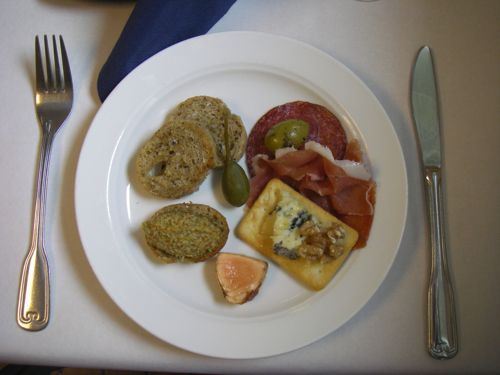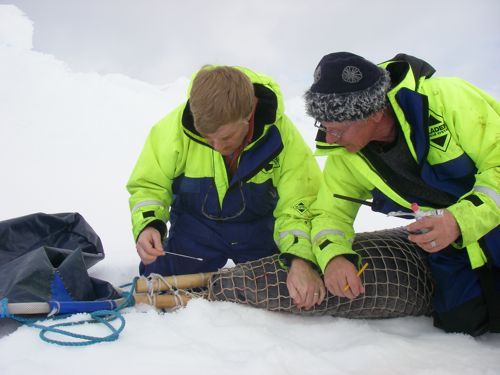Note: We are running a few days behind with these journals due to communications issues with the Oden. Thank you for your patience.
Oden News Flash! Before we get to today's topics I need to make a few announcements....
- Mark Your Calendars and Register for this week's Live From IPY Webinar from the Oden. Go to the PolarTREC.com homepage and sign-up to participate in the one hour live event that will start at 1pm Eastern time this Wednesday, January 7th. I created a document that helps teachers understand how to prepare their classes for a webinar and it is posted on my Dec 13th journal. 2. New videos are coming soon. I am interviewing some of the scientists on board plus I have I am working on videos titled "Krill Safari" and "I Picked a Seal's Nose for Science". Keep checking my journals. You will not want to miss them. 3. January 1st was my daughter Kelly's 21st birthday! Dad loves you.
Happy New Year in Photos
New Year's eve was celebrated while the Oden was tied to an ice flow between the Amundsen and Ross Seas. After completing data collection at the ice station, everyone was invited to get cleaned up and dressed up for a wonderful meal. There were 3 courses including salmon, pork, beef, cheese, steamed vegetables, baked potatoes and ice cream. At midnight the ship's horn blasted and the ship's bell was sounded to welcome in 2009.
On the first day of the new year I was able to modify my underwater video cameras to capture images of the CTD collecting samples and a swarm of krill feeding on algae in the sea ice. Then the seal team asked me to go out in the inflatable boat again to capture more seals. I even got to help hold the seal down and collect specimens of SEAL SNOT! How could not have had a better day or a better start to 2009. Here is a collection of photos that show some of the action. The krill, CTD and snot videos are coming soon.
 When I looked at the beautiful table setting and the expertly prepared holiday meal I kept thinking of some of the other PolarTREC teachers whose remote field assignment would never have afforded them such lavish meal. We are 54 people alone in the wilderness of the Amundsen Sea ice but we have a galley staff of 3 who have done a great job keeping us fed.
When I looked at the beautiful table setting and the expertly prepared holiday meal I kept thinking of some of the other PolarTREC teachers whose remote field assignment would never have afforded them such lavish meal. We are 54 people alone in the wilderness of the Amundsen Sea ice but we have a galley staff of 3 who have done a great job keeping us fed.
 As the Oden pulled up stakes and headed to our next ice station we welcomed 2009 with a beautiful sunny view.
As the Oden pulled up stakes and headed to our next ice station we welcomed 2009 with a beautiful sunny view.
 Dr. Tero Härkönen showed me how to collect nasal swabs. The young crabeater seal didn’t like it any more than I would but swabs will alow the scientists to determine the viruses and bacteria that are affecting the seal’s health.
Dr. Tero Härkönen showed me how to collect nasal swabs. The young crabeater seal didn’t like it any more than I would but swabs will alow the scientists to determine the viruses and bacteria that are affecting the seal’s health.
 The swab is quickly sealed into a sterile tube with preservative. Once the team gets back to Sweden, the bacteria and viruses can be identified. My first concern was to try to comfort the unhappy young seal in the net. I covered his head with canvas and leaned some of my weight on him as Dr. Olle Karlsson had shown me and this seemed to calm the seal. Within minutes the procedures were complete and the seal was released. Watch for an upcoming video that shows my début as a member of the seal research team!
The swab is quickly sealed into a sterile tube with preservative. Once the team gets back to Sweden, the bacteria and viruses can be identified. My first concern was to try to comfort the unhappy young seal in the net. I covered his head with canvas and leaned some of my weight on him as Dr. Olle Karlsson had shown me and this seemed to calm the seal. Within minutes the procedures were complete and the seal was released. Watch for an upcoming video that shows my début as a member of the seal research team!
 The seal’s ancestors lived on land and you can see that the flipper has 5 fingers that each end in a claw. The claws look very much like those of dogs and like dogs, the seal uses them to scratch himself as well as to help climb onto the ice. The seal’s flipper also contains the same three bones that are in a human arm. The seal’s arm bones are shorter and the fingers and hands have become elongated and webbed with skin to form the flipper.
The seal’s ancestors lived on land and you can see that the flipper has 5 fingers that each end in a claw. The claws look very much like those of dogs and like dogs, the seal uses them to scratch himself as well as to help climb onto the ice. The seal’s flipper also contains the same three bones that are in a human arm. The seal’s arm bones are shorter and the fingers and hands have become elongated and webbed with skin to form the flipper.
 There are only 2 species of penguins and 4 species of seals in this part of the Southern Ocean and yet you can see tracks all over snow on the sea ice. It is very easy to tell Adelie tracks from Emperor Penguin tracks because the emperors are at least twice as large and move almost exclusively by sliding on their belly. The size and shape of the belly marks look like someone has pushed a watermelon across the snow with wing marks alternating on each side to help push the giant birds along.
There are only 2 species of penguins and 4 species of seals in this part of the Southern Ocean and yet you can see tracks all over snow on the sea ice. It is very easy to tell Adelie tracks from Emperor Penguin tracks because the emperors are at least twice as large and move almost exclusively by sliding on their belly. The size and shape of the belly marks look like someone has pushed a watermelon across the snow with wing marks alternating on each side to help push the giant birds along.
 Today’s expedition flags flew over the seal research team as they worked with a huge female crabeater seal on the sea ice a mile away from the Oden.
Today’s expedition flags flew over the seal research team as they worked with a huge female crabeater seal on the sea ice a mile away from the Oden.
The flags are held by Bengt Liljebladh and were created by the following schools and camps:
Ms. Ellwood's 8th Grade, Rye Junior High, NH
Cedar Street School, Syracuse, NY
YMCA Camp Indian Springs, Florida
Mr. Huebner, Ravenwood High School, Brentwood, TN
The American Camp Association, National Office, Indiana
Mrs. Doering, St. Francis of Assisi School, St. Louis, MO
Camp Talooli, Camp Fire USA, Pennellville, NY
The Expedition Earth Science Program, Liverpool High School 9th Gr Annex
 Bengt Liljebladh is a Swedish scientist and CTD technician who celebrated his 50th birthday today by skiing a mile out to help the seal research team capture a huge seal that weighed over 470 pounds. He was happy to help fly today’s flags!
Bengt Liljebladh is a Swedish scientist and CTD technician who celebrated his 50th birthday today by skiing a mile out to help the seal research team capture a huge seal that weighed over 470 pounds. He was happy to help fly today’s flags!
Photo Of The Day
 As I rode in the inflatable Zodiac, I took this photo of Oden reflecting in the calm icy water. Notice how small the ice research team looks to the right of the ship. The white ball on top of the ship houses one of the satellite antennas we use to communicate to the rest of the world. The 2 rectangular holes in the bow of the Oden are where the massive anchors are stored. 100 feet above the sea, beneath the red line, you can see the windows of the bridge where I spend most of the evenings working at my computer and watching the polar world go by.
As I rode in the inflatable Zodiac, I took this photo of Oden reflecting in the calm icy water. Notice how small the ice research team looks to the right of the ship. The white ball on top of the ship houses one of the satellite antennas we use to communicate to the rest of the world. The 2 rectangular holes in the bow of the Oden are where the massive anchors are stored. 100 feet above the sea, beneath the red line, you can see the windows of the bridge where I spend most of the evenings working at my computer and watching the polar world go by.
Making memories on the ice,
Jeff Peneston

